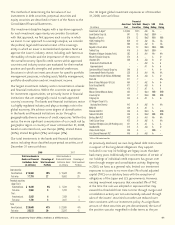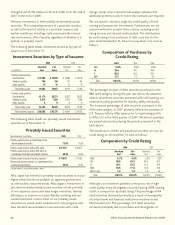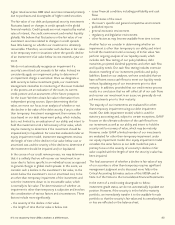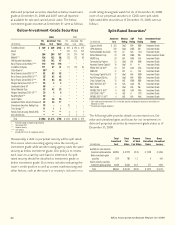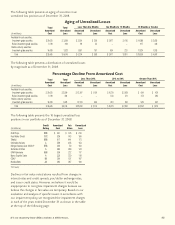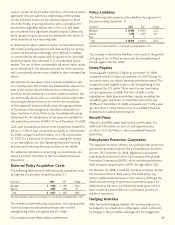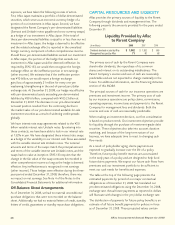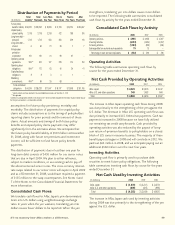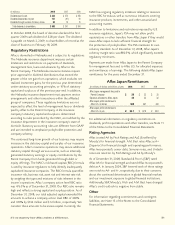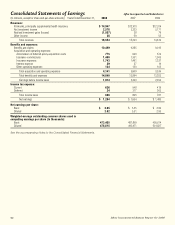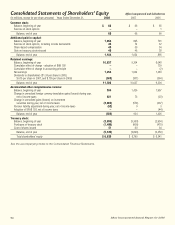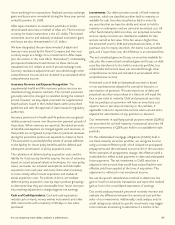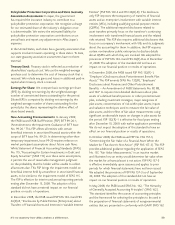Aflac 2008 Annual Report Download - page 55
Download and view the complete annual report
Please find page 55 of the 2008 Aflac annual report below. You can navigate through the pages in the report by either clicking on the pages listed below, or by using the keyword search tool below to find specific information within the annual report.
51
It’s no mystery how Aflac makes a difference.
In October 2008, the board of directors declared the first
quarter 2009 cash dividend of $.28 per share. The dividend
is payable on March 2, 2009, to shareholders of record at the
close of business on February 18, 2009.
Regulatory Restrictions
Aflac is domiciled in Nebraska and is subject to its regulations.
The Nebraska insurance department imposes certain
limitations and restrictions on payments of dividends,
management fees, loans and advances by Aflac to the
Parent Company. The Nebraska insurance statutes require
prior approval for dividend distributions that exceed the
greater of the net gain from operations, which excludes net
realized investment gains, for the previous year determined
under statutory accounting principles, or 10% of statutory
capital and surplus as of the previous year-end. In addition,
the Nebraska insurance department must approve service
arrangements and other transactions within the affiliated
group of companies. These regulatory limitations are not
expected to affect the level of management fees or dividends
paid by Aflac to the Parent Company. A life insurance
company’s statutory capital and surplus is determined
according to rules prescribed by the NAIC, as modified by the
insurance department in the insurance company’s state of
domicile. Statutory accounting rules are different from GAAP
and are intended to emphasize policyholder protection and
company solvency.
The continued long-term growth of our business may require
increases in the statutory capital and surplus of our insurance
operations. Aflac’s insurance operations may secure additional
statutory capital through various sources, such as internally
generated statutory earnings or equity contributions by the
Parent Company from funds generated through debt or
equity offerings. The NAIC’s risk-based capital (RBC) formula
is used by insurance regulators to help identify inadequately
capitalized insurance companies. The RBC formula quantifies
insurance risk, business risk, asset risk and interest rate risk
by weighing the types and mixtures of risks inherent in the
insurer’s operations. Aflac’s company action level RBC ratio
was 476.5% as of December 31, 2008. Our RBC ratio remains
high and reflects a strong capital and surplus position. As of
December 31, 2008, our total adjusted capital exceeded the
amounts to achieve a company action level RBC of 400%
and 350% by $742 million and $1.2 billion, respectively. We
consider these amounts to be excess capital. Currently, the
NAIC has ongoing regulatory initiatives relating to revisions
to the RBC formula as well as numerous initiatives covering
insurance products, investments, and other actuarial and
accounting matters.
In addition to limitations and restrictions imposed by U.S.
insurance regulators, Japan’s FSA may not allow profit
repatriations or other transfers from Aflac Japan if they would
cause Aflac Japan to lack sufficient financial strength for
the protection of policyholders. The FSA maintains its own
solvency standard. As of December 31, 2008, Aflac Japan’s
solvency margin ratio was 880.5%, which significantly exceeds
regulatory minimums.
Payments are made from Aflac Japan to the Parent Company
for management fees and to Aflac U.S. for allocated expenses
and remittances of earnings. The following details Aflac Japan
remittances for the years ended December 31.
For additional information on regulatory restrictions on
dividends, profit repatriations and other transfers, see Note 11
of the Notes to the Consolidated Financial Statements.
Rating Agencies
Aflac is rated AA by Fitch Ratings and Aa2 (Excellent) by
Moody’s for financial strength. A.M. Best rates Aflac as A+
(Superior) for financial strength and operating performance.
Aflac Incorporated’s senior debt, Samurai notes, and Uridashi
notes are rated A+ by Fitch Ratings and A2 by Moody’s.
As of December 31, 2008, Standard & Poor’s (S&P) rated
Aflac AA for financial strength and rated Aflac Incorporated’s
debt as A. In January 2009, S&P lowered each of these ratings
one notch to AA- and A-, respectively, due to their concerns
about the continued deterioration in global financial markets
and our investment exposure to global financial institutions.
Additionally, S&P, Moody’s, Fitch and A.M. Best have changed
Aflac’s credit outlook to negative from stable.
Other
For information regarding commitments and contingent
liabilities, see Note 13 of the Notes to the Consolidated
Financial Statements.
(In millions) 2008 2007
2006
Dividends paid in cash $ 434 $ 373 $ 258
Dividends declared but not paid 131 (91) 91
Dividends through issuance of treasury shares 20 19 15
Total dividends to shareholders $ 585 $ 301 $ 364
Aflac Japan Remittances
(In millions of dollars and billions of yen)
2008 2007
2006
Aflac Japan management fees paid to
Parent Company $ 26 $ 32 $ 25
Expenses allocated to Aflac Japan 36 33 32
Aflac Japan profit remittances to
Aflac U.S. in dollars 598 567 442
Aflac Japan profit remittances to
Aflac U.S. in yen ¥ 64.1 ¥ 67.8 ¥ 50.0


